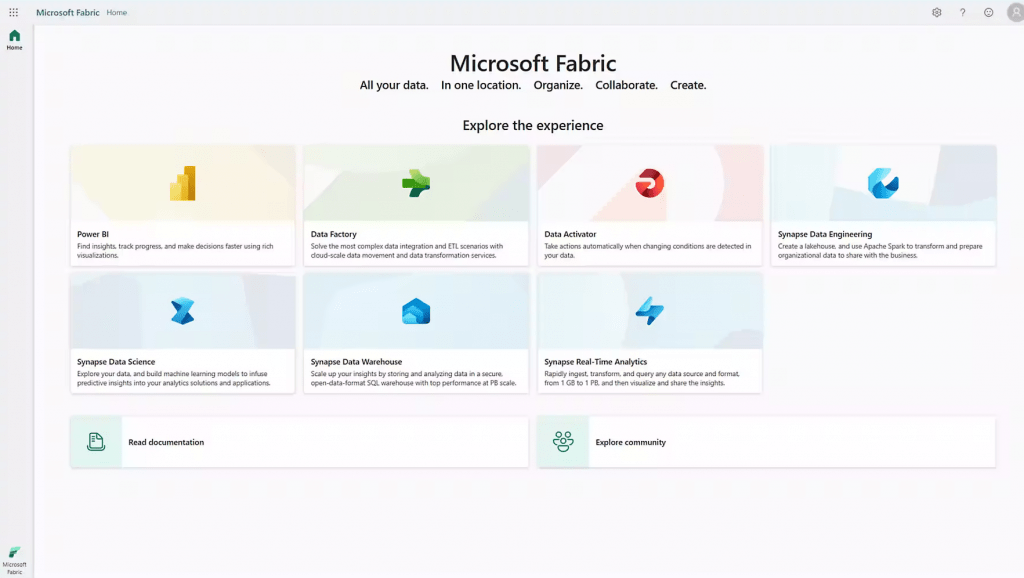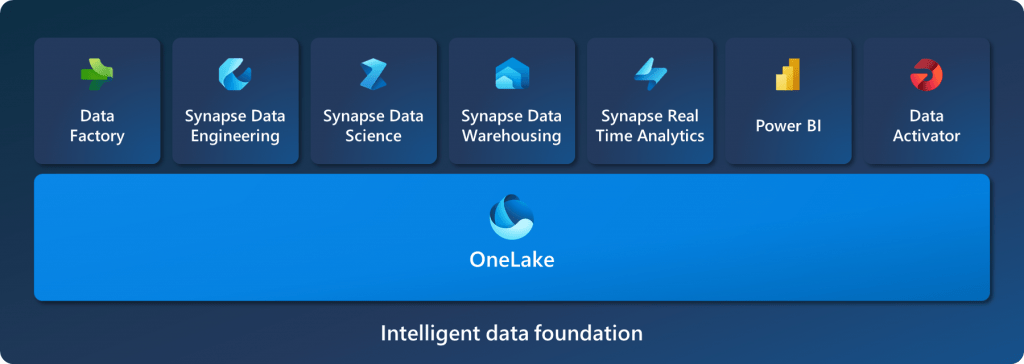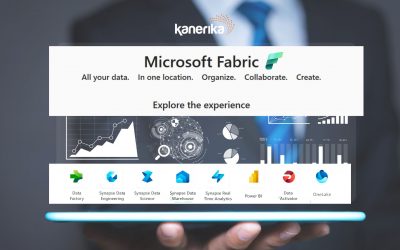In the realm of business intelligence and data analytics, Microsoft has introduced several tools to cater to the diverse needs of enterprises. While Power BI has long been a favourite among business users from multiple industries, Microsoft’s new platform, Fabric, aims to capture an even larger market share.
Quick introduction: Microsoft Fabric is an end-to-end analytics solution launched at Microsoft Build 2023 and is currently accessible to businesses in preview mode. It provides a comprehensive suite of services, including data lake, data engineering, and data integration, all in one place. Power BI is a business intelligence (BI) tool that turns business data into insights. With Power BI, you can easily connect to your data sources, visualize your data, and share your insights with others. simultaneously, its easy-to-use interface makes it popular for business users. Recognizing Power BI’s market share, Microsoft has cleverly packaged it with its Azure Synapse tools and other remarkable technologies into a SaaS platform. This was done to attract existing Power BI customers to shift their entire data analytics cycles to Microsoft. So, let’s delve into a detailed comparison between Microsoft Fabric and Power BI to help you make an informed decision on which is the better tool for your business.
Table of Contents
- Microsoft Fabric vs. Power BI: Understanding the Differences
- Purpose of the Platforms
- Microsoft Fabric vs Power BI: Features
- Microsoft Fabric vs Power BI: Integration Capabilities
- Microsoft Fabric vs Power BI: Architecture and Components
- Additional Considerations
- Which One is Right for You?
- Elevate Your Data Analytics Journey with Kanerika
Microsoft Fabric vs. Power BI: Understanding the Differences
1. Purpose of the Platforms
Microsoft Fabric: Microsoft Fabric is an all-encompassing analytics solution tailored for enterprises. Its primary aim is to provide a comprehensive platform for business users and data analyst to use in unison. Fabric covers everything from data movement to data science, real-time analytics, and business intelligence. Therefore, by consolidating various analytics processes into one platform, Microsoft Fabric seeks to simplify the complex landscape of enterprise analytics. They have made it more accessible and streamlined for businesses of all sizes.
Power BI: On the other hand, Power BI is an interactive data visualization software with a primary focus on business intelligence. It’s designed to transform raw, unrelated data sources into coherent, visually immersive, and interactive insights. Power BI’s primary goal is to empower businesses to make informed decisions by visualizing their data comprehensibly.
2. Microsoft Fabric vs Power BI: Features
Microsoft Fabric: One of the standout features of Microsoft Fabric is its OneLake architecture. As the name implies it serves as the foundational data lake for all its services. This ensures a unified location for storing all organizational data. Additionally, Microsoft Fabric offers a suite of services, including data lake, data engineering, and data integration. This holistic approach ensures that users don’t have to juggle multiple services from different vendors. So, this ensures greater security and accessibility to all kinds of users in an organization.
Power BI: Power BI, in contrast, is renowned for its data visualization capabilities. It offers a collection of software services, apps, and connectors that work in tandem to provide visually immersive insights. Whether it’s reading data from a database, webpage, or structured files like spreadsheets, Power BI can handle it all. Moreover, the cloud-based “Power BI Services” and the “Power BI Desktop” interface enhance its range of features.
Also Read – What Is Microsoft Purview: The Key to Unlocking Effective Data Governance
3. Microsoft Fabric vs Power BI: Integration Capabilities
Microsoft Fabric: Integration is one of the strong suits of Microsoft Fabric. It seamlessly integrates multiple technologies, such as Data Science, Data Engineering, Real-Time Analytics, and Power BI on a shared SaaS platform. This deep integration offers a plethora of benefits. They include various analytics, shared experiences among different users, and a unified data lake that supports and connects various analytics tools.
Power BI: Power BI, too, boasts impressive integration capabilities. It can effortlessly connect with various data sources, be it databases, webpages, or structured files. However, Power BI does not provide users with the integration capabilities of Fabric, and works independently as a business intelligence tool that derives business insights from data.
Also Read – Open Source LLM Models: A Guide to Accessible AI Development
4. Microsoft Fabric vs Power BI: Architecture and Components

Microsoft Fabric: Fabric is built on a robust architecture that comprises various components. They include:
- Data Lake: A secure and scalable repository designed to house all data, regardless of format or structure.
- Data Engineering: An integrated suite designed to transform and prepare data, making it primed for insightful analysis
- Data Integration: These platforms connect various data sources, enabling seamless movement and synchronization between the different sources.
- Machine Learning: A platform tailored for crafting, building, and deploying sophisticated machine learning models.
- Business Intelligence: A specialized tool that empowers data visualization and in-depth analysis, turning raw data into actionable insights.
Power BI: Power BI’s ecosystem, in comparison to Fabric, is limited. Some of the key elements include:
- Power BI Desktop: A desktop application for creating and publishing reports and dashboards.
- Power BI Online: A cloud-based service that achieves the same functionality as Power BI Desktop but allows users to access it from any system online.
- Power BI Mobile: Apps for iOS, Android, and Windows devices for viewing and interacting with reports and dashboards.
Read More – What Is Microsoft Purview: The Key to Unlocking Effective Data Governance
5. Additional Considerations
Scalability: Both Microsoft Fabric and Power BI are scalable solutions. However, with its comprehensive suite of services, Microsoft Fabric is more tailored for large enterprises with complex data analytics needs. With its cloud-based services, Power BI is less complex and focuses on providing users with only one functionality – excellent business intelligence insights.
Learning Curve: Given its comprehensive nature, Microsoft Fabric might have a steeper learning curve than Power BI. Moreover, the latter is more intuitive and user-friendly, especially for those familiar with other Microsoft products like Excel.
Cost: While Power BI offers a free version with limited capabilities, Microsoft Fabric, being an all-in-one solution, may have a justifiably higher tag once it is officially launched into the market. Currently, Fabric is free for existing Power BI customers to try out during the preview mode.
Which One is Right for You?
The best choice for you will depend on your specific needs and requirements. Microsoft Fabric is a good option if you are looking for a comprehensive analytics solution that can handle your entire data funnel. Fabric’s all-in-one solution is perfect for businesses already spending money on multiple tools and technologies to maintain their data cycles. If you are looking for a BI tool to help you visualize and analyze your data, then Power BI is what you need. It is among the easiest tools to use and contains features that help non-technical users derive the most value from their data.
Elevate Your Data Analytics Journey with Kanerika
 With new technologies emerging every year, losing out on all the upgrades is easy if you don’t have the right partner to guide you. Having a strategic partner to navigate the complexities of analytics can be a game-changer for your business. This is where Kanerika steps in. We’re not just another tech company; we’re your bridge to analytics excellence. Leveraging the power of Microsoft Fabric, we offer an unparalleled holistic approach to data analysis.
With new technologies emerging every year, losing out on all the upgrades is easy if you don’t have the right partner to guide you. Having a strategic partner to navigate the complexities of analytics can be a game-changer for your business. This is where Kanerika steps in. We’re not just another tech company; we’re your bridge to analytics excellence. Leveraging the power of Microsoft Fabric, we offer an unparalleled holistic approach to data analysis.
As a proud Microsoft Partner, our exclusive access to Microsoft Fabric’s advanced suite ensures you’re always a step ahead. Thus, maximizing your existing infrastructure. We have deep-rooted expertise in Generative AI and an intricate understanding of the Microsoft Fabric and Power BI. This also positions us uniquely to accelerate your innovation journey. Book your free consultation with us today!
FAQ
How do Microsoft Fabric and Power BI differ in integration capabilities?
What is the strategy behind Microsoft integrating Power BI with Azure Synapse and introducing Microsoft Fabric?
How does Power BI compare to Microsoft Fabric in terms of ease of use and popularity among business users?
How has Microsoft positioned Fabric in relation to Power BI, and what is its strategy regarding existing Power BI users?
How do Microsoft Fabric and Power BI differ in terms of integration and compatibility?
What is the role of Business Intelligence in Microsoft Fabric's architecture?
What are the key elements of Power BI's ecosystem in terms of architecture and components?










